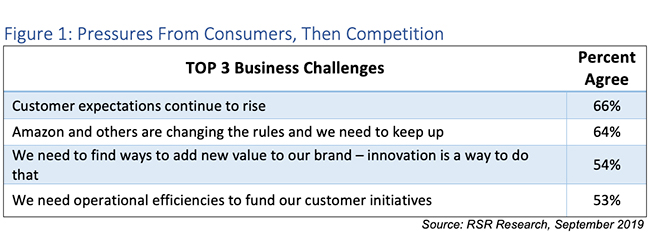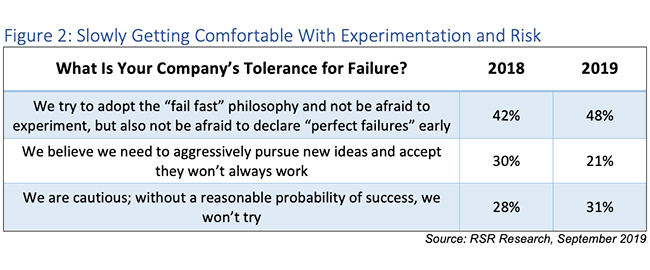
What ‘Innovation' Means to Retailers
For retailers, the Innovation Imperative boils down to two things: keeping up with the rapid pace of consumer adoption of technologies that help them improve their lives, and using what the technology world has to offer to create new efficiencies in core business processes. At least that's what retailers tell us in RSR's latest benchmark study on the state of Innovation in Retail (Innovation in Retail 2019: Keeping It Real).
Retailers acknowledge that a commitment to continuous improvement in the customer experience is the new normal, and that it will be driven by consumer adoption of digital technologies. Frankly, consumers are doing the innovating – most retailers are merely responding in kind. But retailers also seek to take advantage of technology innovations that help them realize new efficiencies in their operating processes.
But despite all the hype surrounding innovation, creating something unique and compelling that can create new barriers to competition is not really on the agenda. Instead, retailers – especially over performing "Retail Winners" – are keeping it real, focusing on doing the little things that will have the greatest impact. Winners focus their innovation efforts in a prioritized way based on clearly defined objectives. Average and under-performers don't exhibit the same discipline. Under performers are worried about their ability to catch up to the leaders; they are more concerned than Winners that the competition is "changing the rules of the game," and they believe they need to find efficiencies to pay for their efforts to catch up with customer expectations.
The pressure that innovative competitors are putting on retailers is a top-three concern. Yet that concern continues to be superseded by the pressure that consumer expectations create (Figure 1).
The 2019 study shows that the challenges that retailers are grappling with are real, and the opportunities that those challenges create for agile retailers are compelling. So, what stands in the way? An insidious cultural challenge persists: old attitudes about technology and experimentation and an aversion to risk. Innovation requires experimentation, and experimentation requires some tolerance for risk.
Generally, the study shows that retailers have become slightly more tolerant of the risks associated with experimentation, as is evidenced by the increased number of retailers that seek to adopt a "fail fast" philosophy. But that willingness also comes with a less aggressive posture when it comes to innovation in general. Caution is still a hallmark of retailer attitudes about technology, and while most innovations today are technology driven, retailers haven't thrown that specific caution to the wind.

What Should Retailers Do?
Innovation isn't a new concept for retailers, despite the popular opinion that the industry as a whole is risk averse. Retailers have a long history of creating innovative product designs and in adopting innovations to either improve the customer experience or improve operational efficiencies. What has changed in the past 20 years is the pace of technology innovation. In today's world, consumer adoption of innovative technologies is driving rapid changes in business, and retailers have struggled to keep up. The industry's slow pace of technology adoption and long amortization cycles stand in the way.
To continue to win customer loyalty, retailers need to do more than create new and exciting products. They need to adopt the same technologies that consumers are using to improve their daily lives to improve the shopping experience. And retailers must accelerate their efforts to use the latest technologies available to improve their operational processes to keep pace with best-in-class operators.
The following are some of the learnings from Retail Winners that every retailer can use to embrace more innovative thinking – regardless of their size, maturity, or geography:
- Focus. Winners focus on those ideas that are likely to have the most impact to achieve an overall objective.
- Pay Attention to What's Going On Around You. Winners look to technologists, adjacent industries, and to customers for new ideas – but always with a specific business objective in mind.
- Don't Always Focus on Doing "More." Being great at work is often the result of doing less – but doing it better. When it comes to winning through innovation, it's best to hyper focus on a few ideas that will yield the most favorable result.
- Information Mastery Is the Innovation Enabler. Information leads to insights, and insights lead to innovations.
- Let Old Habits Die. Retailers face a daunting list of internal obstacles to becoming more innovative. But consumers don't care. Consumers are driving technology adoption, and if retailers want to keep them, they must keep up with them.
Be sure to download RSR's latest benchmark study on the state of Innovation in Retail (Innovation in Retail 2019: Keeping It Real). RSR's research is always free – check it out on www.rsrresearch.com.
If you would like to share your thoughts on retail innovation, drop me a line on LinkedIn or at bkilcourse@rsrresearch.com.



